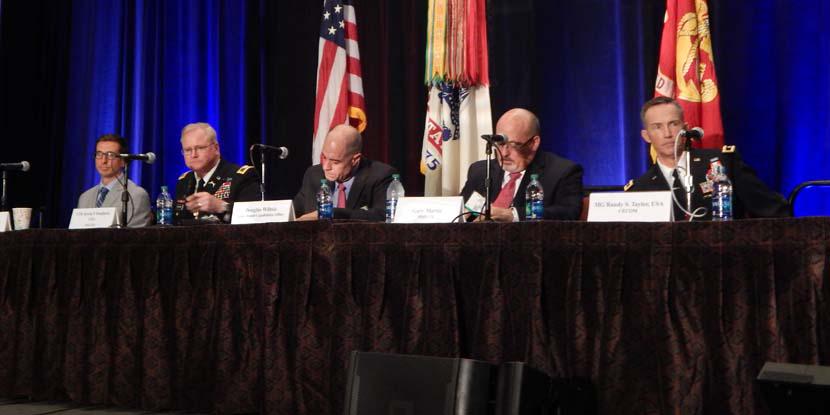U.S. Army Seeks Low-Detection Waveforms
One of the Army’s biggest needs in the area of tactical command, control and communications is radio waveforms that are difficult to detect and intercept.
Gary Martin, the service’s Program Executive Officer for Command, Control and Communications-Tactical, told the AFCEA TechNet Augusta audience that hard-to-find waveforms top the service’s list, and he invited industry’s ideas on the subject.
Martin said the Army also is enhancing some existing waveforms. For example, officials are working with the narrowband Soldier Radio Waveform to allow warfighters to put it on radio silence. The current version of the waveform radiates energy even when not in use. The service also is discussing the best way to improve encryption for SINCGARS, the Single Channel Ground and Airborne Radio Signal.
Martin, @PEOC3T, Next major emphasis on simplicity, designing systems that require no training. #AFCEATechNet
— George Seffers (@gseffers) August 9, 2017
The PEO emphasized the need to simplify systems for soldiers. He reported that the sergeant major of the Army visited Aberdeen Proving Ground the week before the conference and said general purpose information technology systems should not require a manual or training. “That’s an extreme. That may be impossible to do, but ... I think that’s where our next major emphasis needs to be in my space—designing systems that require zero training as an objective,” Martin said.
He listed a variety of other efforts designed to simplify Army tactical C3 systems. Many current systems are too complex, which means they are difficult for soldiers to use without manuals and training and they take too much time to set up and initialize.
He indicated the SINCGARS radios were complex enough, but the issue has only grown worse. “The tactical radios we’re putting out today are even more complex. They’re networking boxes. They’re not simply push-to-talk radios, so they require configurations and network settings and so forth,” Martin said. He added that radios take “a fair amount of manually intensive activities” for initialization.
Martin, @PEOC3T, Today's RF radios are cmplex are basically networking boxes #AFCEATechNet
— George Seffers (@gseffers) August 9, 2017
To help resolve the issue, PEO-C3T hopes to soon begin fielding a system Martin termed “over-the-air demand information networking," which he compared to a cellphone’s ability to detect WiFi in a hotel. The system will detect other networks in the vicinity, provide a network identification and allow the warfighters to request to join the network if they want. “If he presses a button, he’ll get the network presets delivered to him over the air. We’ve added that capability, and we’ll roll it out in about a year,” Martin said.
The service also is enhancing the common operating environment (COE), essentially converging a number of capabilities. “We are currently on schedule to deliver version three of COE for next fall for testing at Network Integration Evaluation 18.2,” he said. Among other improvements, the system will provide a single mapping solution, as well as a common look and feel, whether the warfighter is inside a command post or a vehicle.
In addition, the service has embarked on a major effort to provide a common baseline across mission command centers, working with U.S. Army Forces Command.
The service also has been testing Increment II of the Warfighter Information Network-Tactical (WIN-T) system at the most recent network integration evaluation (NIE). The new version includes a downsized tactical communications node and network operations security center, as well as an improved Soldier Network Extension, which provides mobile satellite communications. “We’ve significantly shrunk it and can now get into a vehicle with about 50 percent less size and weight and what used to be five boxes is now three,” Martin reported. “That will be the next baseline we begin fielding next year.”
Martin, @PEOC3T, Making good progress in downsizing electronics. We have significantly shrunk...WIN-T Increment II components #AFCEATechNet
— George Seffers (@gseffers) August 9, 2017
He also mentioned an effort to begin “tunneling the intel traffic over the operational network or the WIN-T system.” The benefits include a reduced electromagnetic signature as well as smaller size and lower weight.
In addition, the service also is improving cybersecurity for systems under development, ensuring they are evaluated for vulnerabilities early in the developmental process, and WIN-T will be gaining a public key infrastructure capability, reducing the number of passwords required to operate the system.





Comments